Alaska Success Stories
Alaska Native Success Stories
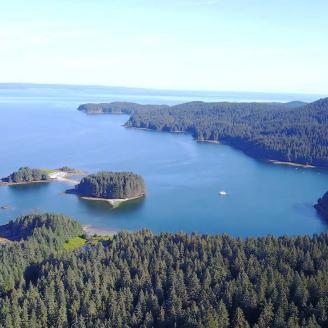
NRCS helps Tribal landowners manage sustainable timber production on Afognak Island, Alaska
NRCS is working with Alaska Native landowners to help them meet their forest management goals to sustain the health and diversity of the landscape.
AFOGNAK ISLAND, ALASKA – Timber production is economically important to Alaska. Timber from Alaska forests is used in a wide range of applications, from construction and building materials to high-end specialty products like musical instruments, sailboat masts, and cultural logs used for panels and totems. While the industry has experienced fluctuations, it remains a significant part of Alaska’s economy as well as the global economy for timber and wood products. To keep this market viable for future generations, there is a critical need for sustainable forestry conservation.
Enter the USDA Natural Resources Conservation Service (NRCS). NRCS is a federal agency under the U.S. Department of Agriculture that works exclusively on private lands, with voluntary private landowners such as farmers, ranchers, non-industrial private forestland owners, and other agricultural producers including those who manage lands for subsistence.

Lower Tyonek Creek Fish Passage Restoration Project
In 2024, the Tyonek Tribal Conservation District, the Tyonek Native Corporation and many partners (including NRCS) completed construction on the Lower Tyonek Fish Passage Restoration Project, a ten-year multi-agency effort that replaced a 6' diameter culvert with a 45'10" diameter culvert, opening up 31 miles of habitat in the watershed. Time-lapse photography was collected to capture the construction process and was stitched together in this video, produced by the Tyonek Tribal Conservation District.
- Watch Timelapse Video (1:41)

Protecting Habitat and Subsistence in Hooper Bay, Alaska
HOOPER BAY, Alaska -- The USDA Natural Resources Conservation Service (NRCS) worked with the village of Hooper Bay, via a contract with private landowners Sealion Corporation, to design and construct a hardened walkway that protects nesting bird habitat on the tundra while allowing safe human access for subsistence activities.
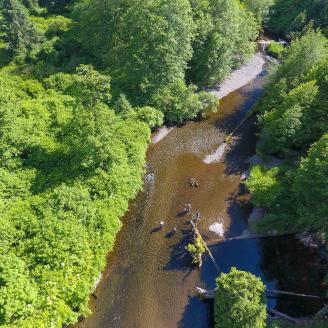
RCPP Success Story - Hoonah Native Forest Partnership
Alaska Native landowners leverage USDA’s Regional Conservation Partnership Program to maintain healthy streams and forests.
Generations of Alaska Native people have thrived upon the land and all that it supports: clean water, fresh air, abundant fish and game, and plants that provide sustenance, medicine, and building materials. A common cultural thread weaves Alaskans together in this enormous state: Alaskans are hunters, harvesters, gatherers, and fishers.
In the remote village of Hoonah, located near the capital of Juneau in Southeast Alaska, the Huna Tlingit people and local residents have cultural roots that are deeply entwined in the land and waters surrounding their community.
Recognizing the importance of protecting, conserving and maintaining the stream and forest habitats that are so integral to the Hoonah way of life, the Hoonah Native Forest Partnership (HNFP) was formed in 2015.
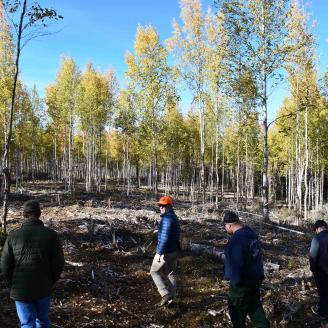
Protecting Communities from Wildfire on the Kenai Peninsula
Public and private partners are working together to reduce wildfire risk surrounding the Kenai National Wildlife Refuge
From the early 1990s through 2017, state and federal agencies installed about 15 miles of fuel break that protected the southern border of Alaska’s Kenai National Wildlife Refuge from catastrophic wildfire. It wasn’t easy work. It demanded years of creatively piecing together various funding sources, building partnerships with public and private entities, performing landscape-level planning, and coordinating implementation activities on the ground.
Now five years later and after two more wildfires that swept through the landscape in 2017 and 2019, that fuels reduction work has expanded onto private lands owned by Alaska Native entities along the north side of the Refuge. Partners have now completed 25 miles of fuel break and finished planning for an additional 10 to 15 miles of fuel break, bringing the total defensible perimeter to 35 to 40 miles.
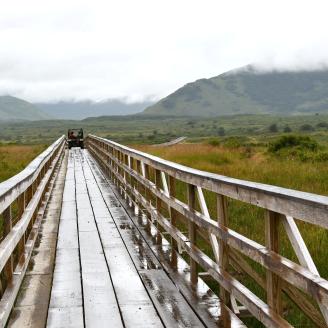
Larsen Bay Trail Preserves Access to Subsistence Areas
Koniag and NRCS are working together to reduce soil erosion and improve access to historical fishing sites on Kodiak Island.
Maintaining safe access to hunting, fishing and gathering areas is a critical need for communities in rural Alaska who depend on subsistence for their livelihood. Wild game like moose, bear and caribou, and aquatic species like salmon are key staples to fill the freezer so that residents have enough food to last through the long winter.
On Kodiak Island in the remote community of Larsen Bay, local residents have traversed a path from the head of Larsen Bay to the Karluk River for generations. The path is a gateway for them to access historical and cultural sites for hunting, fishing, gathering and other subsistence uses.
The path was used long before the passage of the Alaska Native Claims Settlement Act (ANSCA) in 1971, which formed the 12 Regional Corporations and 200+ village corporations that currently own and manage Alaska Native private lands throughout the state.
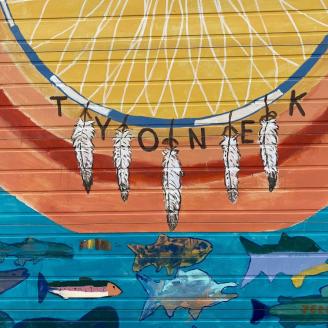
Improving Salmon Habitat and Food Security in Tyonek, Alaska
In a remote community where subsistence is agriculture, partners are working together to remove barriers to fish passage and restore access.
“Subsistence is our Agriculture” – these four words are the crux of food security in Alaska, and the tagline for the Tyonek Tribal Conservation District (TTCD).
The Native Village of Tyonek is located about 40 miles south of Anchorage on the west side of the Cook Inlet. Because no roads connect the village to the rest of Alaska, Tyonek is accessible only by small plane or boat, making food security a paramount concern for residents. About 170 people live in the village year-round.
TTCD was the first Tribal Conservation District established in Alaska in 2005. Since then, the District has ramped up its staffing and capacity to perform a variety of conservation projects that support their mission. They are a key tribal partner with the USDA Natural Resources Conservation Service (NRCS) to accomplish voluntary conservation projects on private lands using Farm Bill programs.
Growing Partnerships with Alaska Native Producers
As the largest private landowners in the state, Alaska Natives play a critical role in getting NRCS conservation programs on-the-ground.
There's no doubt that Alaska is BIG. It's the largest state in the nation with 375 million acres of land. It’s larger than Texas, Montana and California combined! But who owns all of that land?
Roughly 86 percent of Alaska's land is in public ownership (federal and state), and more than 13 percent is private land owned and managed by Alaska Natives. Those native lands span more than 44 million acres, or more than 70,000 square miles. Land in private ownership (other than Alaska Native land) comprises less than one percent of the total land in Alaska.
Alaska also has more Native American tribes than any other state in the nation. There are 229 Federally recognized tribes in Alaska, which is 40 percent of all recognized tribes in the United States.
Forestry Success Stories

Reducing Wildfire Risk in Talkeetna, Alaska
Private landowner Gerald Shearer encourages woodland owners in the Upper Susitna Basin to work with NRCS
TALKEETNA, ALASKA – Like many Alaskans in the Upper Susitna Basin, Gerald Shearer is concerned about the risk of wildfire on his forestland. Recent wildfires in the region such as the Bear Creek Fire (2025), Montana Creek Fire (2024), and the Sockeye Fire (2015) have threatened homes and infrastructure and destroyed forests.
“Black spruce is highly flammable, all you have to do is strike a match to it,” Gerald said. “We had a substantial fire about two miles away [the Montana Creek Fire], and the only reason it didn’t hit us was because the wind came out of the north instead of south. The fire jumped the road and spread fast.”
As a model steward of the land, Gerald has been working on a fuel break on the north end of his property since he bought it in 2013. He found out about the USDA Natural Resources Conservation Service (NRCS) from his neighbor and has been working with NRCS since 2018 to reduce wildfire risk on his 430-acre property.
Conservation Innovation Success Stories

Tracking Cattle with GPS in Alaska
Herding cattle in Alaska can be a challenge, especially considering most of the state is not connected to a contiguous road system. Getting cows out to remote rangelands requires herding or trucking them for long distances, and once they are there, it can be difficult to monitor their movements as they traverse vast, rugged landscapes with limited options for human access.
A team of ranchers on Alaska’s Southern Kenai Peninsula are seeking innovative solutions to monitor cattle on the 16,000-acre Fox River Flats state grazing lease area. The land is owned by the State of Alaska and is managed by the Fox River Cattlemen's Association (FRCA).
Food Security Success Stories
Partnerships Support Sustainable Food Production in Kake, Alaska
NRCS is working with partners to support local food production in rural Alaska communities while addressing soil health conservation.
KAKE, ALASKA – (September 2025) -- Staff with Central Council of Tlingit & Haida, Eklutna Tribal Conservation District, Chugach Regional Resources Commission, Alaska Pacific University's Alaska Tilth Program, and NRCS traveled to Kake, Alaska to help expand their community garden and orchard.
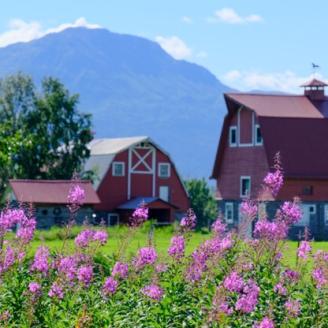
NRCS and Alaska Farmland Trust protect historic Grover Farm in Palmer, Alaska
In the heart of Alaska’s rich agricultural region, the Alaska Farmland Trust Corporation (AFTC), in partnership with the USDA Natural Resources Conservation Service (NRCS), permanently protected the 115.22-acre Grover Farm through a conservation easement that ensures the land will remain in agricultural use forever.
Established in 1948 by Clifton and Vera Grover, the farm has stood for over seven decades as a pillar of family farming in the Matanuska Valley. Originally a dairy operation, they shifted over time to running cattle and began to lease portions of the property to other local farmers— continuing a legacy of local food production and stewardship.
NRCS Helps Residents Grow Food Security in Alaska
Approximately 95% of Alaska's purchased food is imported, accounting for around $2 billion in sales sent out of state each year. NRCS provides assistance to Alaskans who are growing their own food to help them improve crop quality, manage soil nutrients, improve irrigation efficiency, and more.
HOMER, ALASKA – Food security is a concern for all Alaskans. Approximately 95 percent of food purchased in Alaska is imported, accounting for around $2 billion in sales sent out of state each year, according to the Alaska Food Policy Council. Because of its remote location, extended winter climate, and short growing season, the logistics of getting food to Alaska comes with a high price tag.
“We’re in rural Alaska. Everything that comes into our community that we go and buy in our grocery store is trucked in or shipped in,” said Margaret Johnson, a peony and berry grower in Homer.
“Food security is huge, just being able to have the quality of food that you want, and then also the affordability factor,” said Ryan Lee, Homer resident and backyard gardener.
Alaskans like Margaret and Ryan, and many others, are stepping up to the challenge and growing their own food through small-scale agriculture. The number of farms in Alaska continues to grow. According to the 2022 Census of Agriculture, Alaska showed a 54% increase in the total number of farms from 2012 to 2022, and Alaska now ranks second in the nation for percentage of female farmers and new/beginning farmers.

Homer Hilltop Farm: From Backyard Garden to Thriving Farm
USDA programs help Homer, Alaska-based farmer grow her business and improve food sovereignty
Like many farmers in Alaska, Carey Restino got started with a simple backyard garden. Just a few raised beds, where she and her two toddlers could experience the joy of getting their hands in the soil, exploring what foods they could grow, and hopefully glean a youthful lesson or two about hard work and nature.
Now, nearly two decades later, Carey is the primary owner and operator of a thriving farm business that has more than quadrupled in size and consistently grosses six-figures. Her farm provides a steady source of nutritious, organically grown food and awe-inspiring flowers to the community. Her son Liam, and daughter Théa—now in their early adult years—are still integral members of the enterprise.
Carey reflected on the growth of the farm and attributes the U.S. Department of Agriculture as a key player in her success. She worked with two USDA agencies – the Natural Resources Conservation Service (NRCS) and the Farm Service Agency (FSA) – and has used multiple financial assistance programs and loan programs to expand her operation over the years.

Protecting Farmland in Palmer, Alaska...Forever.
Moffitt Farm, Alaska Farmland Trust and NRCS work together to preserve open spaces through Agricultural Conservation Easement Program
In the small farming town of Palmer, Alaska, the threat of development is real.
In the last 20 years, more and more people are discovering the quality-of-life benefits offered by Palmer’s picturesque mountains, abundant rivers, and fertile farmlands.
According to the City of Palmer website, “Palmer has transformed from a peaceful rural area to a rural bedroom community, and most recently, to an increasingly self-sufficient, commercial employment center.”
The City also states that the population growth in Palmer and the surrounding area has been significant; and the City's population has increased an average of 3.3 percent since 2000, with 6,323 residents currently residing in the 5.2-square-mile city.
Like many towns in rural America, managing growth responsibly is paramount to expand opportunities for economic development while preserving the town’s historic character, natural resources, and quality of small-town life.
For local farmers, that means protecting their farmland…forever.
“When I look around at the sub-divisions and the houses that have gone up around here, I feel a sinking feeling in my stomach. I have no desire to see my family’s legacy become a bunch of houses,” said Tracy Moffitt, a third-generation farmer in Palmer.

Pandemic Spurs Community Supported Agriculture in Seldovia, Alaska
This off-road Alaskan community depends on planes & boats to haul in most of their food, but local farmers are sowing seeds of change...
Rosanna McInnes never really considered herself a farmer…until the COVID-19 pandemic hit. Prior to 2020, she was just another gardener, growing flowers and vegetables in her backyard to feed her family. But the pandemic caused delays in food supply chains, especially in rural villages off the road system, like Rosanna’s hometown of Seldovia, Alaska.
Seldovia is 25 miles away from the popular fishing town of Homer on the Kenai Peninsula. It’s only accessible by plane or boat. The year-round population is 277 people according to the 2020 Census, but the seasonal population ranges from 1,000 to 2,000 during the summer tourism season.
Beginning Farmer Success Stories
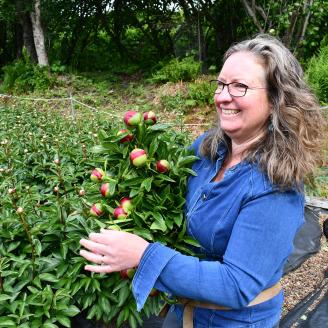
Conservation Helps Alaska's Niche Peony Market Bloom
Allison Gaylord, peony farmer and founding member of Alaska Beauty Peony Co-op is maximizing water efficiency with support from NRCS.
Peonies have a special place in Alaska agriculture. Our long summer days under the midnight sun and a late growing season allow for harvest in July and August; a time when most other peony farms in the world have already finished their harvests for the year.
"Alaska has a niche market for peonies because we are the last to harvest them in North America; we fill a gap in production of fresh cut peonies to create a year round market for this favorite feature flower," said Allison Gaylord, peony farmer, founding member and Board Chair of the Alaska Beauty Peony Co-op in Homer, Alaska.

Conservation at The Rustic Peony in Ninilchik, Alaska
The Natural Resources Conservation Service (NRCS) helps Tiffany and Brian McCorison optimize irrigation and diversify their farm.
Tiffany and Brian McCorison moved to Alaska because they wanted a sustainable life.
"We have always been hunters, fishers, and gatherers," Tiffany said. "We want to be self-sustaining."
Tiffany grew up in Montana; Brian in Minnesota. They chose the small oceanside community of Ninilchik, Alaska as their home to settle down, raise their three children, and start a farming business.
Tiffany and Brian bought the property in 2015 and immediately began the laborious process of clearing two acres for farming.
They initially decided to focus on peony production and planted 1,000 peony plants; and that was the beginning of their boutique agrotourism business, The Rustic Peony.
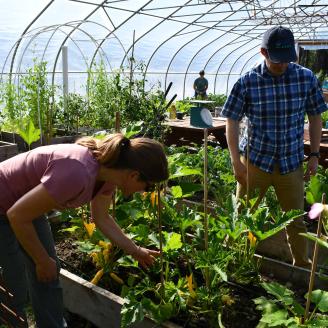
Conservation on Tap at Denali Brewing Company
This iconic Alaska brewery is improving soil nutrients, increasing crop health & producing local food using composted spent grain.
Denali Brewing is a popular craft brewery and restaurant in Talkeetna, Alaska, about 100 miles north of Anchorage flanked by stunning views of the Talkeetna mountain range. The brewery is named for Mount Denali (20,310 feet), the highest peak in North America.
Owners and operators Sassan and Kristy Mossanen are stewards of the land and they work tirelessly to reduce and reuse all forms of waste generated at the brewery. Sustainability and conservation are core values to them, and they live by those values when making business decisions.
Watershed Programs Success Stories
Relocating Homes from Severe Erosion in Akiak
Relocating Homes from Severe Erosion in Akiak, Alaska
Akiak Native Community and Natural Resources Conservation Service work together to respond to natural disasters and plan for the future.
Akiak resident Ted Williams sits on the edge of an outdoor basketball court, gazing out toward the Kuskokwim River, his feet dangling above an eroded streambank.
“I remember sitting here when I was 12 years old – but back then the boardwalk used to go all the way out into the river,” Ted said. “The elders told me not to sit there because it was eroding…but I never thought it would erode this much.”
A short walk down the shoreline, Ted looks out at another stretch of river.
“The road used to be out where the river is now,” Ted said. “This used to be where my grandparents lived. It’s all in the river now....It’s rapidly eroding.”
Protecting Lives and Infrastructure from Erosion in McGrath
The City of McGrath, Alaska used the NRCS Emergency Watershed Protection Program to respond to rapid erosion on the Kuskokwim River.
Erosion is an inevitable fact of life on the Kuskokwim River. The river is a force of nature. It ebbs and flows. It bends and straightens. It freezes and thaws. The river changes every year as the continuous cycle of winter to summer creates dynamic movements that transform the landscape.
The Kuskokwim is the second largest drainage in Alaska, stretching 900 miles from the Alaska Range mountains to the Bering Sea.
The people who live along its banks are well accustomed to the Kuskokwim’s ways. The river is their life blood. It’s their source for fish. It’s their highway for transportation and commerce. It allows them to receive critical goods and fuel via barge. It’s the source of drinking water for some communities.
But at times the river can also be their nemesis. It can threaten their lives, infrastructure, and property.
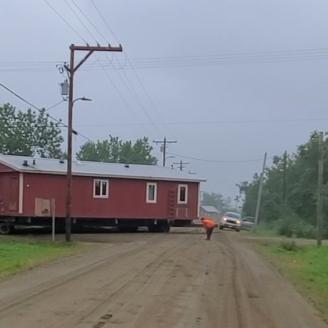
Relocating Homes in Kwethluk and Akiak during a Pandemic
When natural disaster strikes, the USDA Natural Resources Conservation Service (NRCS) is a resource to help communities rebuild via its Emergency Watershed Protection (EWP) program.
EWP relieves imminent hazards to life and property caused by floods, fires, windstorms, heavy rains, and other natural occurrences.
In Alaska, Tribal governments are often the primary local sponsors requesting federal assistance through EWP. In 2020, NRCS provided EWP assistance to two Federally-recognized Tribes in rural Alaska to relocate homes threatened by rapid riverbank erosion.
The Akiak Native Community and the Organized Village of Kwethluk requested and received EWP assistance to relocate 11 homes. Both villages are located on the lower Kuskokwim River, the longest free-flowing river in the United States.
Relocating Homes in Huslia
In 2014 and 2018, the Huslia Village Council requested assistance from NRCS through the EWP program, due to increased erosion during spring break-up. Projects were funded by NRCS in FY2014 and FY2019, respectively.
-
AK Huslia EWP Success Story (15.66 MB)
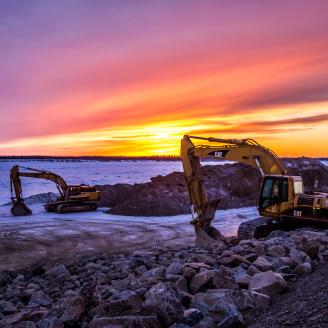
Ice Roads and Ice Jams in Galena
Through the Emergency Watershed Protection (EWP) program, the off-road community of Galena repaired a levee with NRCS assistance. The levee protects the airport, a school, and other village infrastructure. The levee had been damaged during a flood, which was caused by an ice jam on the Yukon River during spring break-up.
-
AK Galena EWP Success Story (1.89 MB)

City of Valdez - EWP at the End of the Road
The City of Valdez needed to protect the Prince William Sound regional emergency broadcast tower from falling into the Valdez Glacier Stream. The Natural Resources Conservation Service, through the Emergency Watershed Protection (EWP) program, had a solution: a training dike.
-
AK Valdez EWP Success Story (1.76 MB)
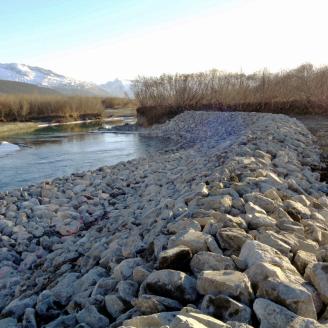
Responding to a Glacial Outburst Flood in Seward
A jökulhlaup, an Icelandic word pronounced yo-KOOL-lahp, is a glacial outburst flood. It occurs when a lake fed by glacial meltwater breaches its dam. It is usually sudden and violent. A jökulhlaup near Seward, Alaska, resulted in streambank erosion on the Snow River, creating a serious threat to life and property
-
AK Seward EWP Success Story (989.97 KB)
Soil Health Success Stories
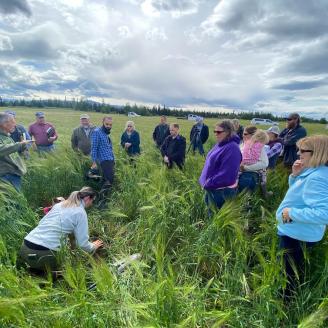
Delta Junction Farmers Explore Soil Health
3rd Annual Soil Health Field Day encourages Alaska farmers to put away the plow and discover the cover.
Local farmers and natural resource professionals gathered at the Alaska Flour Company to learn about regenerative agricultural practices that build healthier, more resilient soils during the Third Annual Soil Health Field Day, hosted by the Salcha-Delta Soil and Water Conservation District (SWCD).
Bryce Wrigley, owner and operator of Wrigley Farm and the Alaska Flour Company, hosted the event on his farm and shared his personal experience with using no-till and cover crops on his barley operation. Wrigley is also the district manager of the Salcha-Delta Soil and Water Conservation and has served in that role since 2004.
This year’s event featured guest speaker Jay Fuhrer, a world-renowned expert in soil health management practices from Bismarck, North Dakota. Fuhrer is a retired soil health specialist from the USDA Natural Resources Conservation Service (NRCS) with 40 years of experience working with cropping systems, grazing systems, cover crops and gardens. He works on the Menoken Farm, a 150-acre demonstration farm east of Bismarck owned and operated by the Burleigh County Soil Conservation District.

Alaska Flour Company Builds Healthy Soils and Food Security
Father-son duo Bryce and Milo Wrigley produce sustainable barley foods using soil-friendly farming practices like no-till and cover crops.
Alaskan farmer Bryce Wrigley is not just a barley farmer; he’s a zookeeper. His zoo consists of billions of living things that are invisible to the naked eye. He feeds them, nurtures them, and ensures they are healthy and productive.
Can you guess what they are? Soil microorganisms!
In just one teaspoon of healthy soil, there are more than six billion living things such as bacteria, fungi, protozoa, nematodes, earthworms and arthropods. These tiny critters make up the soil food web, and their transactional relationships with one another directly affect the health and productivity one of humankind’s most precious resources: soil.

Alaska Farmers on a Quest for Healthy Soils
Field trial at the Plant Materials Center seeks answers to cover cropping and no-till on the Last Frontier.
The State of Alaska Plant Materials Center (PMC) partnered with NRCS to lead a large-scale, minimum 5-year trial. Within the first year of the trial, Soil and Water Conservation Districts (SWCDs) came to the table with interest in doing similar trials with local farmers. The primary purpose of the PMC trial is to show the effects of cover crops on soil properties and validate the benefits of soil health between rotations in a commodity crop harvest.


